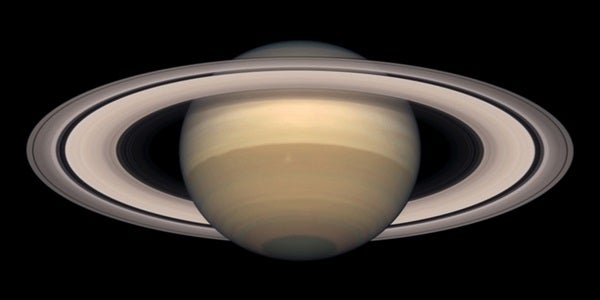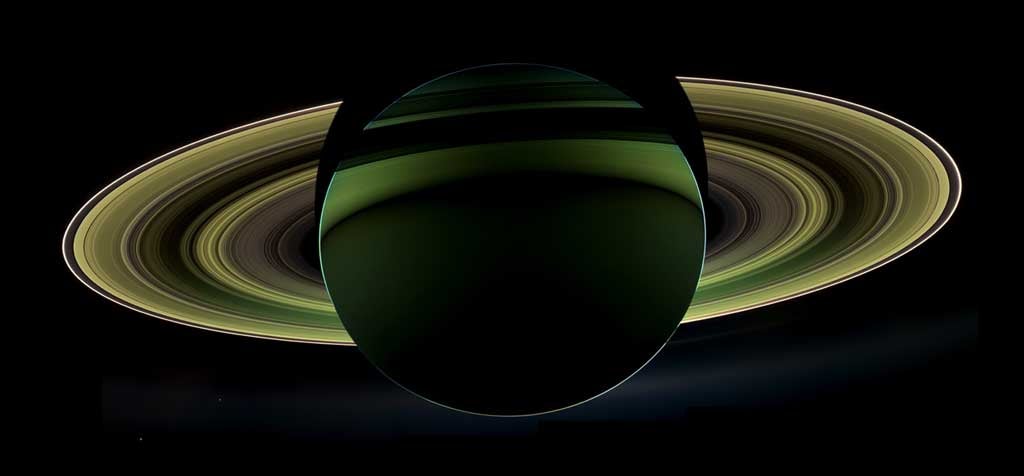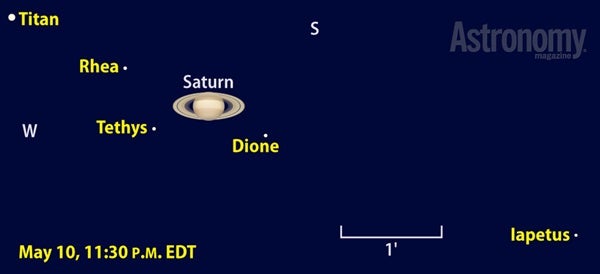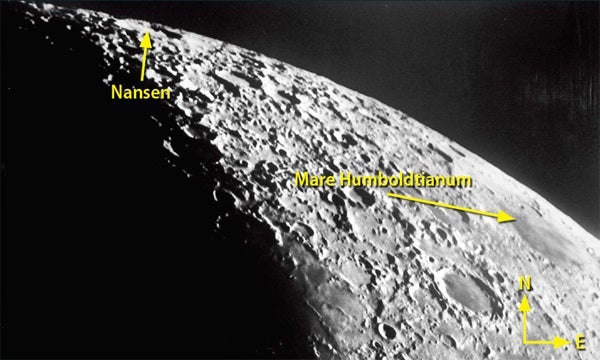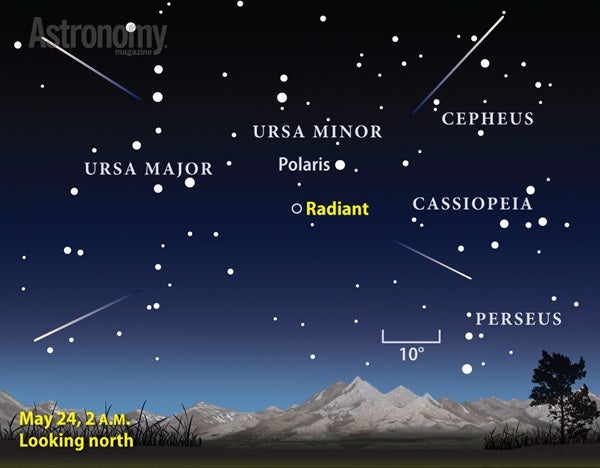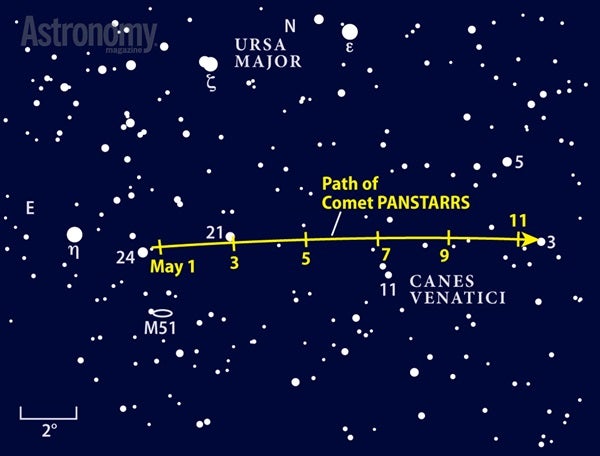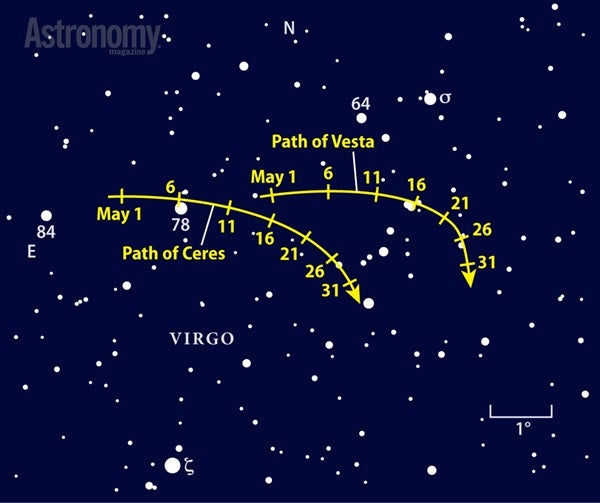Three planets provide a stunning variety of viewing options this spring. Do you like tracking atmospheric features? Jupiter offers plenty of opportunities in early evening. Do you prefer seeing planetary surfaces? Mars, now just one month past its best, continues an eye-catching show nearly all night. Or perhaps gorgeous ring systems excite you most? Then don’t miss Saturn, which reaches opposition and peak visibility in May, with its rings open wider than at any time since 2005. Add Mercury glowing bright in evening twilight and Venus dominating before dawn, and May’s smorgasbord rivals any this year.
Let’s begin our tour with the vista that awaits on May’s first evening. The Pleiades and Hyades star clusters in Taurus the Bull hang low in the west as twilight fades to darkness. To their left, you’ll spot Orion the Hunter’s familiar form starting to slip below the horizon. Continue scanning to the left, and you can’t miss the sky’s brightest star, Sirius, probably twinkling like crazy as its light passes through thick layers of air near the horizon.
Above the Hyades stands a smiling crescent Moon, with just 8 percent of its visible surface lit. Crane your neck higher, and you’ll spot Jupiter’s brilliant orb nearly halfway from the western horizon to the zenith. The giant planet glows near the center of Gemini the Twins, just below that constellation’s brightest stars, Castor and Pollux.
Mercury joins the evening scene at the end of May’s first week when it passes 3° south of the Pleiades. The innermost planet shines at magnitude –1.1, far brighter than the star cluster. Use binoculars for the best view. By May 13, Mercury has dimmed to magnitude –0.6 as it slides 8° north of 1st-magnitude Aldebaran, Taurus’ brightest star.
The inner world reaches its peak May 24 when it lies 23° east of the Sun, the maximum elongation for this evening appearance. Although Mercury has faded to magnitude 0.4, it sets a full two hours after our star.
While Mercury is bright, Jupiter is dazzling. The giant planet shines at magnitude –2.0 May 1 and fades by just 0.2 magnitude during the month, values that beat every other planet and star in the evening sky. And Jupiter remains on display for hours, setting near midnight local daylight time in mid-May.
For the best views of Jupiter through a telescope, start observing within an hour after sunset. Its greater altitude in early evening will deliver sharper views of atmospheric features.
The planet’s disk spans an impressive 34″ at midmonth. This is big enough that even small telescopes will show two dark equatorial belts sandwiched around a brighter equatorial zone. Larger apertures reveal more belts and zones as well as details within these cloud bands. The Great Red Spot — a fairly strong shade of orange earlier this year — also should show up nicely when it is on the Earth-facing hemisphere.
Jupiter’s four bright moons present an ever-changing display. Although it’s worth following Io, Europa, Ganymede, and Callisto any time Jupiter is visible, the most exciting views come when one or more moons pass in front of the planet or cast shadows onto the cloud tops.
A moon’s black shadow is particularly easy to spot. A good observing opportunity comes the evening of May 5 when Ganymede’s shadow treks across Jupiter’s face. The black dot first touches the cloud tops at 10:08 p.m. EDT; 90 minutes later, the shadow appears near the disk’s center.
If you watch throughout this period, you’ll notice Europa approaching the planet’s eastern limb. At 12:37 a.m. EDT, this moon begins a transit. Observers in western North America can view Ganymede’s shadow and Europa complete their transits.
More often than not, all four moons shine against a dark background sky. One or two occasionally disappear from easy visibility when they pass in front of or behind Jupiter. Only rarely do three go missing, leaving just one moon set against the sky. You have a chance to witness such an event the evening of May 30 when Callisto lies well east of the planet but Europa is transiting Jupiter while the planet blocks both Io and Ganymede from view.
Callisto remains the only conspicuous satellite from 10:57 p.m. to 12:55 a.m. EDT. Midway through this period, however, you will see Europa’s shadow start to transit the jovian disk. And sharp-eyed observers in western North America might briefly glimpse Ganymede. The solar system’s largest moon reappears from behind Jupiter’s wide disk at 9:00 p.m. PDT, only to be eclipsed by the giant planet’s shadow three minutes later.
After viewing Jupiter, shift your gaze about 90° east to find Mars. The Red Planet shines brightly among the background stars of Virgo the Maiden, appearing high in the southeastern sky as darkness falls in early May.
Mars reached opposition and peak visibility in April, and it remains impressive during May. But no other outer planet changes as quickly as Mars does. It shines at magnitude –1.2 May 1 and dims to magnitude –0.5, a drop of nearly 50 percent, by the 31st. Still, that’s brighter than any star once Sirius sets.
The planet’s apparent diameter also shrinks during May, from 14.6″ to 11.9″. That’s still big enough to show surface features clearly through 4-inch and larger telescopes, particularly during moments of good seeing when turbulence in Earth’s atmosphere dies down. The best times to view are when Mars climbs highest in the south, from midevening until 1 or 2 a.m.
The easiest feature to see on most nights will be the north polar cap. The white expanse stands out despite the direct sunlight beating down during the northern hemisphere’s summer. The cap appears particularly prominent now because the planet’s north pole tilts 25° in Earth’s direction.
Mars rotates on its axis once every 24.7 hours, so its visible hemisphere shifts slightly from night to night. Syrtis Major, the planet’s best known and most conspicuous dark feature, appears front and center during May’s first week. It is visible as soon as the sky grows dark and remains on view until well past midnight. Evening highlights during May’s second week include the bright plains of Elysium and a dark band to its south called Mare Cimmerium.
Saturn lies among the background stars of Libra the Balance, one constellation east of Mars’ current home in Virgo. The ringed world reaches opposition May 10, when it lies opposite the Sun in our sky. As you might guess, this means the planet rises at sunset, climbs highest in the south around 1 a.m. local daylight time, and sets as the Sun comes up. Opposition also brings Saturn closest to Earth, so it shines brightest for the year (at magnitude 0.1).
Opposition marks the peak time for observing any outer planet. Not only does a distant world then remain visible all night and shine brightest, but it also appears largest through a telescope. On May 10, Saturn’s disk measures 18.7″ across while its stunning ring system spans 42.4″. The rings tilt 22° to our line of sight and reveal exquisite detail through any scope. Although the planet shrinks as we get further from opposition, the change is barely detectable — the ring system’s diameter drops only 0.3″ by month’s end.
Saturn also has several moons that show up through small instruments. Any telescope reveals 8th-magnitude Titan, while a 4-inch scope brings Tethys, Dione, and Rhea — all 10th-magnitude satellites — into view. A 4-inch instrument also should show you Iapetus, which glows at 11th magnitude when it passes north of Saturn on May 6. For more information about viewing the ringed world, turn to “See Saturn in prime time” on p. 62.
As Saturn dips toward the western horizon with the approach of dawn, Neptune climbs in the southeastern sky. The distant planet rises about three hours before the Sun in mid-May and appears some 15° high as twilight commences. You’ll need binoculars or a telescope to spot magnitude 7.9 Neptune.
Look for it on the line that joins 4th-magnitude Lambda (λ) Aquarii and 5th-magnitude Sigma (σ) Aqr. Neptune stands 2° from the fainter star. The planet spends May inside a triangle of 7th-magnitude suns.
Venus rises about 100 minutes before the Sun in mid-May, just as twilight starts to paint the sky. But don’t let dawn’s approach scare you away — the planet appears so bright, at magnitude –4.0, that it remains prominent up to a half-hour before sunrise. Point a telescope at Venus, and you’ll see a 15″-diameter disk that appears nearly three-quarters illuminated.
Our final planet this month lurks in Venus’ vicinity. Uranus lies 1.3° north of Venus on May 15. With an exceptionally clear sky and an unobstructed eastern horizon, you should be able to spot the distant planet through 7×50 binoculars.
Uranus glows at magnitude 5.9 — 0.01 percent as bright as its neighbor. The outer world will be easier to find in coming months as it climbs higher in a dark sky.
A FRIGID SEA BECKONS IN LUNA’S NORTHEAST
A big draw to solar system observing is the chance to see objects with a 3-D perspective. Nowhere is this effect greater than along the Moon’s limb.
We gain the strongest sense of depth from shadows cast by tall crater rims onto the floors below. At low Sun angles, shadows appear so sharp and long that they actually exaggerate the relief. The effect led early selenographers to think that the lunar terrain is jagged. If you view the limb at high power, however, you’ll see the profile is much smoother — bumpy, to be sure, but not saw-toothed.
Examine the waxing crescent Moon on the evening of May 2. The first thing that jumps out at you is sunrise on the magnificent Mare Crisium. After you gawk at its semicircle of peaks towering over an uneven floor, scan northward along the limb until you reach a large flat zone punctuated by a dark swath. This is Mare Humboldtianum, the flooded center of a large basin. Farther north and close to the cusp (where the crescent comes to a point) lies the crater Nansen. Named after Norwegian polar explorer Fridtjof Nansen, the crater’s broad and tall rim casts a wall of shadow onto its floor.
The shadows retreat over the next few evenings, but so does Nansen itself. You’ll also notice less real estate between the lunar limb and maria Humboldtianum and Crisium, as if the Moon is turning its face away from us. What’s happening? Although the Moon spins at a constant rate, its orbital speed varies because it travels an elliptical path around Earth. In early May, the Moon is on the slower part of its journey. Astronomers call this apparent rolling motion “libration.”
As Full Moon approaches, watch Mare Crisium librate closer to the limb. You can follow the changing orientation through binoculars or a telescope.
COULD A NEW STORM BE BREWING?
Two meteor shows should grace our skies this month. The first is a relatively known quantity. The Eta Aquarid shower peaks before dawn May 6 and could produce up to 40 meteors per hour under optimal conditions. The best views come under a dark sky after the waxing crescent Moon sets around 1:30 a.m. local daylight time. The shower is best from the Southern Hemisphere, where the radiant — the point from which the meteors appear to come — climbs high.
But a new shower could outduel the Eta Aquarids this year. Astronomers predict that Earth will pass through debris from Comet 209P/LINEAR before dawn May 24. The resulting shower could produce 100 meteors per hour or more. And with essentially no interference from a crescent Moon that rises around 3 a.m. local daylight time, viewing conditions will be excellent. The shower’s radiant lies nearly due north near the border between Ursa Major and Camelopardalis.
| WHEN TO VIEW THE PLANETS |
||
| Evening Sky |
Midnight | Morning Sky |
| Mercury (northwest) |
Mars (southwest) |
Venus (east) |
| Mars (south) |
Jupiter (northwest) |
Saturn (southwest) |
| Jupiter (west) |
Saturn (south) |
Uranus (east) |
| Saturn (southeast) |
Neptune (southeast) |
|
| |
||
A FROZEN VISITOR SWEEPS PAST THE WHIRLPOOL
Astroimagers should mark their calendars for May 1. On that evening, Comet PANSTARRS (C/2012 K1) glides just 2° north of the beautiful Whirlpool Galaxy (M51) in Canes Venatici. The pair remain reasonably close a night or two on either side of the 1st. The grand spiral galaxy glows at 8th magnitude, coincidentally the same brightness as the vastly smaller but closer ball of ice and dust sailing through the inner solar system. From a dark-sky site, the two show up through binoculars as similarly round, gray cotton balls south and west of 2nd-magnitude Eta (η) Ursae Majoris, the star at the end of the Big Dipper’s handle.
As you apply more aperture and magnification to both objects, they look increasingly different. Compare and contrast their shapes and characters. If you ignore M51’s small companion galaxy, NGC 5195, the Whirlpool appears quite round and has a sharply defined outer edge. The comet, on the other hand, looks noticeably lopsided, with a curved bright northern edge and a broad fan that spreads southward before diffusing into the background sky.
The central parts of both the comet and galaxy grow brighter toward the middle. The comet’s coma is a ball of gas and dust that cloaks the dark surface of the comet’s nucleus. A dark object also lurks at the Whirlpool’s center, but even the Hubble Space Telescope can’t image the supermassive black hole that lies in this galaxy’s core.
In the second half of May, C/2012 K1 departs Canes Venatici and enters the modestly rich galaxy country south of the Big Dipper’s bowl. On the 20th, the comet shares a high-power field of view with the 10th-magnitude spiral galaxy NGC 3726.
WHEN (MINOR) PLANETS ALIGN
Asteroids 1 Ceres and 4 Vesta troll a relatively sparse region of northern Virgo during May, making the two brightest asteroids fairly easy to spot. They lie between 2° and 3° apart and some 15° northeast of brilliant Mars, placing them about halfway up in the southeastern sky after darkness falls. Although the two reached opposition and peak brightness in mid-April, they remain fine targets in May.
Are you up for a challenge? Try to see Vesta move with just your naked eyes. This asteroid shines brighter than the typical magnitude 6.5 limit for an average dark sky. To detect its motion, you need to observe it on two moonless nights. Make your first sighting in early May and the second in the month’s final week. Locate Vesta on the map below, and then make a chart that includes four or five of the brighter stars in its area. Memorize the chart, and use it as a framework for your search.
Ceres is slightly out of naked-eye range, but it shows up easily through binoculars in the same field of view as Vesta. You can track the steady motions of both objects through a 3-inch telescope from the suburbs. For much more on observing these asteroids this spring and summer, see “View Ceres and Vesta at their best” on p. 52.
Martin Ratcliffe provides planetarium development for Sky-Skan, Inc. from his home in Wichita, Kansas. Meteorologist Alister Ling works for Environment Canada in Edmonton, Alberta.

